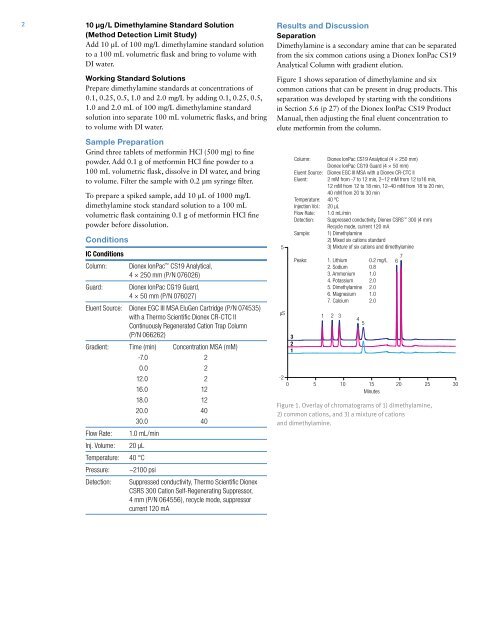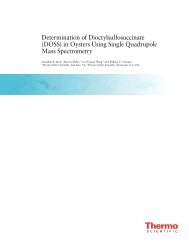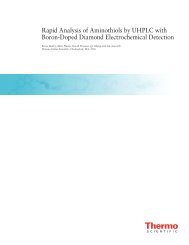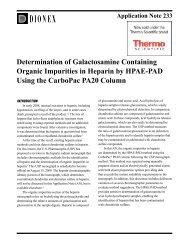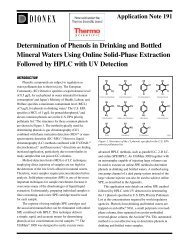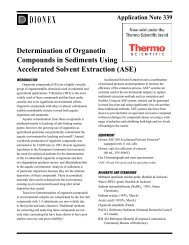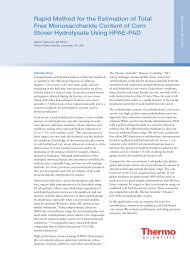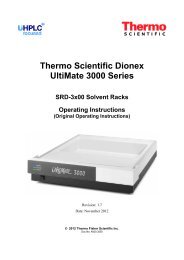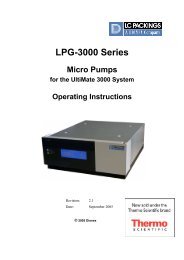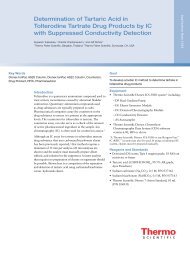Determination of Dimethylamine in Metformin HCl Drug ... - Dionex
Determination of Dimethylamine in Metformin HCl Drug ... - Dionex
Determination of Dimethylamine in Metformin HCl Drug ... - Dionex
You also want an ePaper? Increase the reach of your titles
YUMPU automatically turns print PDFs into web optimized ePapers that Google loves.
2 Results and Discussion<br />
10 µg/L <strong>Dimethylam<strong>in</strong>e</strong> Standard Solution<br />
(Method Detection Limit Study)<br />
Add 10 µL <strong>of</strong> 100 mg/L dimethylam<strong>in</strong>e standard solution<br />
to a 100 mL volumetric flask and br<strong>in</strong>g to volume with<br />
DI water.<br />
Work<strong>in</strong>g Standard Solutions<br />
Prepare dimethylam<strong>in</strong>e standards at concentrations <strong>of</strong><br />
0.1, 0.25, 0.5, 1.0 and 2.0 mg/L by add<strong>in</strong>g 0.1, 0.25, 0.5,<br />
1.0 and 2.0 mL <strong>of</strong> 100 mg/L dimethylam<strong>in</strong>e standard<br />
solution <strong>in</strong>to separate 100 mL volumetric flasks, and br<strong>in</strong>g<br />
to volume with DI water.<br />
Sample Preparation<br />
Gr<strong>in</strong>d three tablets <strong>of</strong> metform<strong>in</strong> <strong>HCl</strong> (500 mg) to f<strong>in</strong>e<br />
powder. Add 0.1 g <strong>of</strong> metform<strong>in</strong> <strong>HCl</strong> f<strong>in</strong>e powder to a<br />
100 mL volumetric flask, dissolve <strong>in</strong> DI water, and br<strong>in</strong>g<br />
to volume. Filter the sample with 0.2 µm syr<strong>in</strong>ge filter.<br />
To prepare a spiked sample, add 10 µL <strong>of</strong> 1000 mg/L<br />
dimethylam<strong>in</strong>e stock standard solution to a 100 mL<br />
volumetric flask conta<strong>in</strong><strong>in</strong>g 0.1 g <strong>of</strong> metform<strong>in</strong> <strong>HCl</strong> f<strong>in</strong>e<br />
powder before dissolution.<br />
Conditions<br />
IC Conditions<br />
Column: <strong>Dionex</strong> IonPac CS19 Analytical,<br />
4 × 250 mm (P/N 076026)<br />
Guard: <strong>Dionex</strong> IonPac CG19 Guard,<br />
4 × 50 mm (P/N 076027)<br />
Eluent Source: <strong>Dionex</strong> EGC III MSA EluGen Cartridge (P/N 074535)<br />
with a Thermo Scientific <strong>Dionex</strong> CR-CTC II<br />
Cont<strong>in</strong>uously Regenerated Cation Trap Column<br />
(P/N 066262)<br />
Gradient: Time (m<strong>in</strong>) Concentration MSA (mM)<br />
-7.0 2<br />
0.0 2<br />
12.0 2<br />
16.0 12<br />
18.0 12<br />
20.0 40<br />
30.0 40<br />
Flow Rate: 1.0 mL/m<strong>in</strong><br />
Inj. Volume: 20 µL<br />
Temperature: 40 °C<br />
Pressure: ~2100 psi<br />
Detection: Suppressed conductivity, Thermo Scientific <strong>Dionex</strong><br />
CSRS 300 Cation Self-Regenerat<strong>in</strong>g Suppressor,<br />
4 mm (P/N 064556), recycle mode, suppressor<br />
current 120 mA<br />
Separation<br />
<strong>Dimethylam<strong>in</strong>e</strong> is a secondary am<strong>in</strong>e that can be separated<br />
from the six common cations us<strong>in</strong>g a <strong>Dionex</strong> IonPac CS19<br />
Analytical Column with gradient elution.<br />
Figure 1 shows separation <strong>of</strong> dimethylam<strong>in</strong>e and six<br />
common cations that can be present <strong>in</strong> drug products. This<br />
separation was developed by start<strong>in</strong>g with the conditions<br />
<strong>in</strong> Section 5.6 (p 27) <strong>of</strong> the <strong>Dionex</strong> IonPac CS19 Product<br />
Manual, then adjust<strong>in</strong>g the f<strong>in</strong>al eluent concentration to<br />
elute metform<strong>in</strong> from the column.<br />
5<br />
µS<br />
3<br />
2<br />
1<br />
Column: <strong>Dionex</strong> IonPac CS19 Analytical (4 × 250 mm)<br />
<strong>Dionex</strong> IonPac CG19 Guard (4 × 50 mm)<br />
Eluent Source: <strong>Dionex</strong> EGC III MSA with a <strong>Dionex</strong> CR-CTC II<br />
Eluent: 2 mM from -7 to 12 m<strong>in</strong>, 2–12 mM from 12 to16 m<strong>in</strong>,<br />
12 mM from 12 to 18 m<strong>in</strong>, 12–40 mM from 18 to 20 m<strong>in</strong>,<br />
40 mM from 20 to 30 m<strong>in</strong><br />
Temperature: 40 ºC<br />
Injection Vol.: 20 µL<br />
Flow Rate: 1.0 mL/m<strong>in</strong><br />
Detection: Suppressed conductivity, <strong>Dionex</strong> CSRS 300 (4 mm)<br />
Recycle mode, current 120 mA<br />
Sample: 1) <strong>Dimethylam<strong>in</strong>e</strong><br />
2) Mixed six cations standard<br />
3) Mixture <strong>of</strong> six cations and dimethylam<strong>in</strong>e<br />
Peaks: 1. Lithium 0.2 mg/L<br />
2. Sodium 0.8<br />
3. Ammonium 1.0<br />
4. Potassium 2.0<br />
5. <strong>Dimethylam<strong>in</strong>e</strong> 2.0<br />
6. Magnesium 1.0<br />
7. Calcium 2.0<br />
1 2 3<br />
4 5<br />
-2<br />
0 5 10 15<br />
M<strong>in</strong>utes<br />
20 25 30<br />
Figure 1. Overlay <strong>of</strong> chromatograms <strong>of</strong> 1) dimethylam<strong>in</strong>e,<br />
2) common cations, and 3) a mixture <strong>of</strong> cations<br />
and dimethylam<strong>in</strong>e.<br />
6 7


